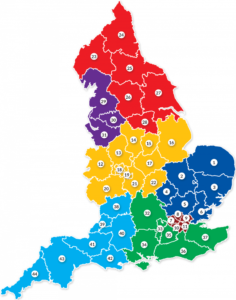In a letter to health leaders, on 1st April 2025, Sir Jim acknowledged cutting Integrated Care Board (ICB) costs by 50% “will be a challenge”, whilst confirming the bodies will be central to future plans. Sir Jim said:
ICBs have a critical role to play in the future as strategic commissioners and this is going to be central to realising the ambitions that will be set out in the 10-Year Health Plan.”

42 ICBs in the NHS in England
What is an ICB (Integrated Care Board)?
They are the current sub-regional structures that organise the NHS in England. There are 42 ICBs in England. As part of the first stage of the Government’s plan to abolish NHS England, the funding of their staff is being reduced by 50% in an attempt to reduce NHS bureaucracy and costs. It is likely that they will merge into 15-ish ‘mega-ICBs’. The future of the 7 NHS Regions ‘above them’ is unclear.
So, what did his letter say?
Guidance will be laid out this month on a reasonable running cost per head of the population that ICBs are expected to use create “bottom-up plans” for sign off by the end of May, with implementation in the third quarter.
In terms of ICB staff reduction, Sir Jim laid out a number of areas of duplication, including assurance and regulatory functions, wider performance management and comms and engagement.
Sir Jim also set out how NHS trusts should reduce corporate cost growth by 50% by quarter three 2025/26, with savings reinvested locally in frontline services.
He highlighted the ‘substantial increase’ in non-patient facing corporate nursing roles at NHS trusts and ICBs since 2019; adding chief nursing officer for England, Duncan Burton, will lead work this month on setting thresholds that systems and providers will be expected to align with in 2025/26.
Sir Jim also revealed the unpopular elective payment limit will be scrapped, adding an Urgent and Emergency Care Delivery plan will be published shortly to ensure services are better prepared for next winter.
The chief executive said work on merging NHSE with the DHSC would continue to be led Penny Dash and Alan Milburn to “create a single aligned centre”.
(A bit of) History of NHS Organisational Structure
The NHS is so large (biggest employer in Europe and 5th biggest in the World) that it needs organisational structures.
The current ICBs are sub-regional and about ‘county-size’ and cover approximately 1 million people. They came into being in 2022, each being formed out of the merger of 3-5ish more local organisations called Clinical Commissioning Groups (CCGs).
ICBs are equivalent to a previous entity called ‘Area’, formed in 1973 and abolished in 1982 (this is their history). These (not very interesting!) organisational changes are summarised in MyHSN’s Short History of the NHS.
The creation of ‘mega-ICBs’ now seems likely (again to reduce costs), and will lead to a more local ‘power vacuum’. It is unclear what will fill that vacuum. Another (!) more local level of administration seems likely. Time will tell.
Does of any of this matter?
Not really. The vast majority of the public is blissfully unaware of the history and politics of NHS reorganisations.
The study of previous ones [“an odd (and slightly dull) interest of this website, you may have noticed ” MyHSN Ed] tells us they take 2+ years. In this period nothing happens, and change is not possible.
They also cost alot, and most of the people in the previous structure, lose jobs then regain them in the new shiny structure. They rarely address any of the real problems of the NHS; many of which relate to long-term issues, which are largely cultural (inefficiency, and poor performance and accounting).
Other resources
History of NHS Timeline
NHS regions and ICBs
Jammed NHS hospitals: 5 problems and solutions
The NHS

